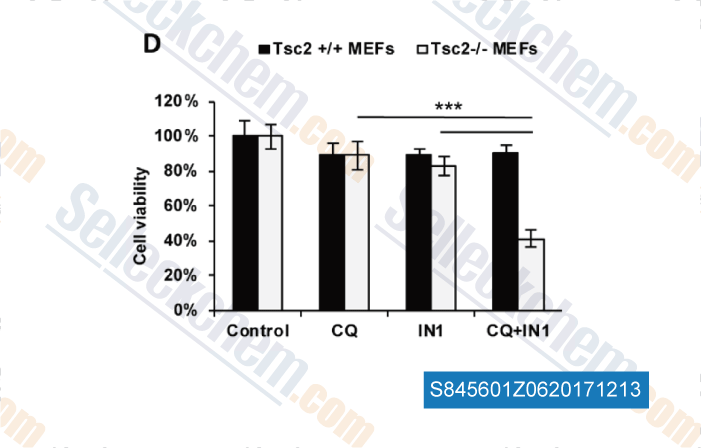|
Toll Free: (877) 796-6397 -- USA and Canada only -- |
Fax: +1-832-582-8590 Orders: +1-832-582-8158 |
Tech Support: +1-832-582-8158 Ext:3 Please provide your Order Number in the email. |
Technical Data
| Formula | C21H25N7O |
|||
| Molecular Weight | 391.47 | CAS No. | 1383716-46-8 | |
| Solubility (25°C)* | In vitro | DMSO | 78 mg/mL (199.24 mM) | |
| Water | Insoluble | |||
| Ethanol | Insoluble | |||
|
* <1 mg/ml means slightly soluble or insoluble. * Please note that Selleck tests the solubility of all compounds in-house, and the actual solubility may differ slightly from published values. This is normal and is due to slight batch-to-batch variations. * Room temperature shipping (Stability testing shows this product can be shipped without any cooling measures.) |
||||
Preparing Stock Solutions
Biological Activity
| Description | VPS34 inhibitor 1 (Compound 19, PIK-III analogue) is a potent and selective inhibitor of VPS34 with an IC50 of 15 nM. | ||
|---|---|---|---|
| Targets |
|
||
| In vitro | Compound 19 is extraordinarily selective over other lipid and protein kinases. The ability of compound 19 to prevent the degradation of autophagy substrates p62, NCOA4, NBR1, NDP52, and FTH1 is similar to PIK-III. In addition, treatment of cells with compound 19 leads to an increase in the lipidated and nonlipidated forms of LC3 similar to previous reports using PIK-III[1]. | ||
| In vivo | The pharmacokinetic profile of analogue 19 is determined in C57BL/6 mice. After oral administration at 10 mg/kg, the compound is rapidly absorbed and showed moderate mean systemic clearance (30 mL/min/kg, approximately 33% of hepatic blood flow), with good oral bioavailability (F% = 47). Based on these PK parameters and the cellular activity, compound 19 constitutes a suitable candidate for in vivo studies. Upon oral administration of compound 19 at 50 mg/kg twice a day (BID) for 7 days, LC3-II accumulates consistent with reduced autophagic capacity in time-dependent manner. It inhibits autophagy in vivo[1]. |
Protocol (from reference)
| Cell Assay:[1] |
|
|---|---|
| Animal Study:[1] |
|
Customer Product Validation

-
Data from [Data independently produced by , , Oncotarget, 2017, 8(24):38099-38112]
Selleck's VPS34 inhibitor 1 (Compound 19) has been cited by 8 publications
| PROX1 induction by autolysosomal activity stabilizes persister-like state of colon cancer via feedback repression of the NOX1-mTORC1 pathway [ Cell Rep, 2023, S2211-1247(23)00530-2] | PubMed: 37224811 |
| Upregulation of the EGFR/MEK1/MAPK1/2 signaling axis as a mechanism of resistance to antiestrogen‑induced BimEL dependent apoptosis in ER+ breast cancer cells [ Int J Oncol, 2023, 62(2)20] | PubMed: 36524361 |
| Endosomal phosphatidylinositol 3-phosphate controls synaptic vesicle cycling and neurotransmission [ EMBO J, 2022, 10.15252/embj.2021109352] | PubMed: 35318705 |
| Subtractive CRISPR screen identifies the ATG16L1/vacuolar ATPase axis as required for non-canonical LC3 lipidation [ Cell Rep, 2021, 37(4):109899] | PubMed: 34706226 |
| Identification of Required Host Factors for SARS-CoV-2 Infection in Human Cells [ Cell, 2020, S0092-8674(20)31394-5] | PubMed: 33147445 |
| Subtractive CRISPR screen identifies factors involved in non-canonical LC3 lipidation. [ bioRxiv, 2020, 10.1101/2020.11.18.388306] | PubMed: None |
| The Chick Chorioallantoic Membrane (CAM) Assay as a Three-dimensional Model to Study Autophagy in Cancer Cells [ Bio Protoc, 2019, 9(13):e3290] | PubMed: 33654803 |
| Lysosomal regulation of cholesterol homeostasis in tuberous sclerosis complex is mediated via NPC1 and LDL-R. [Filippakis H, et al. Oncotarget, 2017, 8(24):38099-38112] | PubMed: 28498820 |
RETURN POLICY
Selleck Chemical’s Unconditional Return Policy ensures a smooth online shopping experience for our customers. If you are in any way unsatisfied with your purchase, you may return any item(s) within 7 days of receiving it. In the event of product quality issues, either protocol related or product related problems, you may return any item(s) within 365 days from the original purchase date. Please follow the instructions below when returning products.
SHIPPING AND STORAGE
Selleck products are transported at room temperature. If you receive the product at room temperature, please rest assured, the Selleck Quality Inspection Department has conducted experiments to verify that the normal temperature placement of one month will not affect the biological activity of powder products. After collecting, please store the product according to the requirements described in the datasheet. Most Selleck products are stable under the recommended conditions.
NOT FOR HUMAN, VETERINARY DIAGNOSTIC OR THERAPEUTIC USE.
